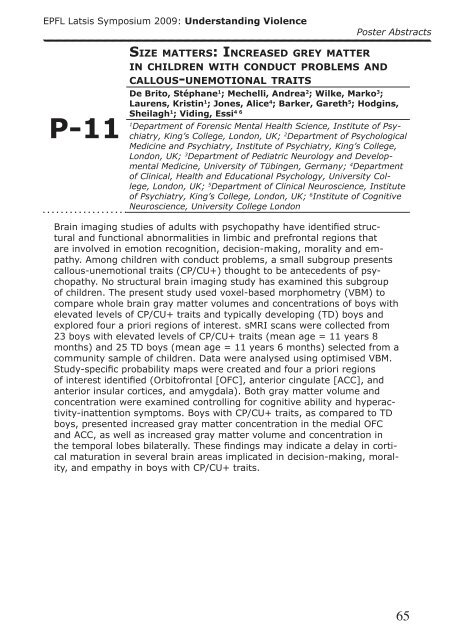Program & Abstract Book - EPFL Latsis Symposium 2009
Program & Abstract Book - EPFL Latsis Symposium 2009
Program & Abstract Book - EPFL Latsis Symposium 2009
Create successful ePaper yourself
Turn your PDF publications into a flip-book with our unique Google optimized e-Paper software.
<strong>EPFL</strong> <strong>Latsis</strong> <strong>Symposium</strong> <strong>2009</strong>: Understanding Violence<br />
P-11<br />
si z e m a t t e r s: in c r e a s e D g r e y m a t t e r<br />
in c h i l D r e n w i t h c o n D u c t p r o b l e m s a n D<br />
c a l l o u s-u n e m o t i o n a l t r a i t s<br />
Poster <strong>Abstract</strong>s<br />
De Brito, Stéphane1 ; Mechelli, Andrea2 ; Wilke, Marko3 ;<br />
Laurens, Kristin1 ; Jones, Alice4 ; Barker, Gareth5 ; Hodgins,<br />
Sheilagh1 4 6<br />
; Viding, Essi<br />
1 Department of Forensic Mental Health Science, Institute of Psychiatry,<br />
King’s College, London, UK; 2 Department of Psychological<br />
Medicine and Psychiatry, Institute of Psychiatry, King’s College,<br />
London, UK; 3 Department of Pediatric Neurology and Developmental<br />
Medicine, University of Tübingen, Germany; 4 Department<br />
of Clinical, Health and Educational Psychology, University College,<br />
London, UK; 5 Department of Clinical Neuroscience, Institute<br />
of Psychiatry, King’s College, London, UK; 6 Institute of Cognitive<br />
Neuroscience, University College London<br />
Brain imaging studies of adults with psychopathy have identified structural<br />
and functional abnormalities in limbic and prefrontal regions that<br />
are involved in emotion recognition, decision-making, morality and empathy.<br />
Among children with conduct problems, a small subgroup presents<br />
callous-unemotional traits (CP/CU+) thought to be antecedents of psychopathy.<br />
No structural brain imaging study has examined this subgroup<br />
of children. The present study used voxel-based morphometry (VBM) to<br />
compare whole brain gray matter volumes and concentrations of boys with<br />
elevated levels of CP/CU+ traits and typically developing (TD) boys and<br />
explored four a priori regions of interest. sMRI scans were collected from<br />
23 boys with elevated levels of CP/CU+ traits (mean age = 11 years 8<br />
months) and 25 TD boys (mean age = 11 years 6 months) selected from a<br />
community sample of children. Data were analysed using optimised VBM.<br />
Study-specific probability maps were created and four a priori regions<br />
of interest identified (Orbitofrontal [OFC], anterior cingulate [ACC], and<br />
anterior insular cortices, and amygdala). Both gray matter volume and<br />
concentration were examined controlling for cognitive ability and hyperactivity-inattention<br />
symptoms. Boys with CP/CU+ traits, as compared to TD<br />
boys, presented increased gray matter concentration in the medial OFC<br />
and ACC, as well as increased gray matter volume and concentration in<br />
the temporal lobes bilaterally. These findings may indicate a delay in cortical<br />
maturation in several brain areas implicated in decision-making, morality,<br />
and empathy in boys with CP/CU+ traits.<br />
65


